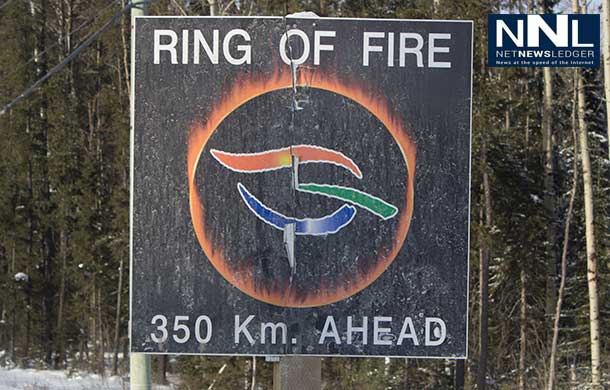
THUNDER BAY – It appears all is not as smooth sailing for road construction in the Ring of Fire in Northern Ontario. Today two First Nations Leaders predicted that the recent road projects for the Ring of Fire announced by the Wynne Government would hit a dead end without real and concrete jurisdiction agreement with First Nations.
“I am disappointed to see an announcement by the Wynne government about building roads in our territories when there is no community approval of a proposed agreement recognizing the inherent rights and treaty rights of first Nations over territories.” said Eabametoong Chief Liz Atlookan.
“The reality is that all the roads to the Ring of Fire traverse the territory of our Nations, and nothing is happening without the free, prior, and informed consent of our First Nations,” said Neskantaga Chief Wayne Moonias who was not at the announcement in Thunder Bay.
The leadership of Eabametoong and Neskantaga First Nations gathered today to affirm their longstanding relationship and considered the premature announcements by the Wynne Government regarding potential roads to the Ring of Fire area.
Earlier this week, the Premier travelled to Thunder Bay, and flanked by Minister Gravelle and Minister Mauro and Chiefs from Marten Falls, Webequie and Nibinamik First Nations announced a plan to build roads connecting their communities to the provincial highway network.
The proposed roads to the Noront project cross the rivers and lands of Neskantaga and Eabametoong.
Neskantaga and Eabametoong First Nations have been actively working to have their rights recognized by Ontario, along with all 9 Matawa-member First Nations, at the Regional Framework Negotiations and the Jurisdiction Table. Both of these processes are intended by our Nations to be collective, community-driven discussions.
Citing a ‘divisive’ approach as being behind the Wynne Government announcement, the two communities of Neskantaga and Eabametoong pledged to honour their respective community processes and to ensure that a concrete agreement over First Nations jurisdiction is actually in place as a pre-condition to road approvals. The Elders and Youth of both communities have stated their support for the positions taken by the leadership:
Neskantaga First Nation Youth, Justin Yellowhead stated: “It is our generation and our children’s children whose rights are at stake here. After you guys are gone it’s going to be our job to fix everything, and we are the ones who will have to struggle if our waters are poisoned and our kids won’t be able to experience the great hunting and fishing we have right now. The youth should be listened to the most. It’s not fair that we were left out of this big decision.”
Eabametoong First Nation Youth, Justin Morris stated: “We don’t agree with Ontario’s approach. We want our rights to be taken seriously. What is happening with the roads and jurisdiction is huge. We can’t mess this up. All Matawa First Nations need to stand together collectively. This is our land we are talking about. We hunt, fish and camp. It is all important to us.”
Neskantaga First Nation Elder, Alex Moonias stated: “When Premier Wynne and Ministers Gravelle, Zimmer, and Mauro prayed with us in ceremony, exchanged gifts and signed the Regional Framework Agreement in 2014, I thought they understood our connection to the lands and the need to recognize who we are. I am not so sure any more.”
Eabametoong First Nation Elder, Cornelius Nate stated: “There is no way to place a value on our lands, the animal life we are bound to protect and our way of life we have been maintaining for generations. The Creator put us on this land for a reason and we have responsibilities to protect our land and waters for future generations.”
BACKGROUNDER
On October 6, 2016 at a Matawa Chiefs meeting with Premier Wynne a Jurisdiction Table was created.
The Objective of the Jurisdiction Table was the Definition of the Statement of Shared Commitments between Ontario and the Matawa First Nations that establish the basis on which key future decisions will be made within the Ring of Fire region, including a commitment to consent-based decision making on:
- The development of new access and industrial roads into the Matawa territories, and decisions respecting road ownership and governance
- The planning and approval of major industrial or resource development projects
- Regional planning, environmental assessment and monitoring
- The establishment of renewed institutions of First Nation governance and collective decision-making.
The Matawa Jurisdiction Table discussions have not concluded and no agreement has been reached on First Nation jurisdiction in the Ring of Fire region.
On August 21, 2017 Ontario announced that they were supporting a First Nation proposal to plan and construct a year-round access road into the proposed mining development site being pursued by Noront Resources Ltd and were working with Webequie, Marten Falls and Nibinamik First Nations to build all-season access roads to their communities.
On April 25, 2014 Premier Wynne, Ministers Gravelle, Zimmer and Mauro and the Matawa First Nations celebrated a historic Framework for Negotiations on the Ring of Fire. The event included First Nation traditional ceremonies, a commemorative signing ceremony with Premier Wynne and an exchange of gifts.
The Regional Framework Agreement was to be the first step in the historic, community-based negotiation process to bring together all nine Matawa First Nations and the Province of Ontario to discuss and negotiate an approach for development in the First Nations’ homelands.
The proposed roads, railways and mining development will profoundly impact the pristine river systems and lands that Neskantaga and Eabametoong have used and occupied since time immemorial.
The Ring of Fire, located in a roadless region 540 kilometres northeast of Thunder Bay, is promoted by the mining industry and province as one of the most significant mineral regions in Canada and Ontario’s oil sands.





